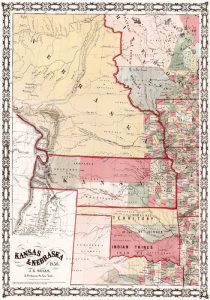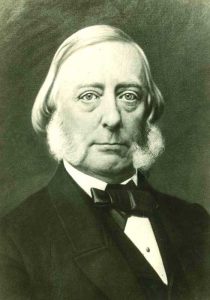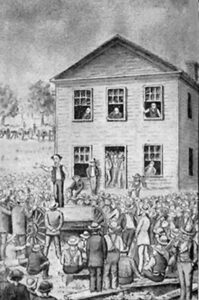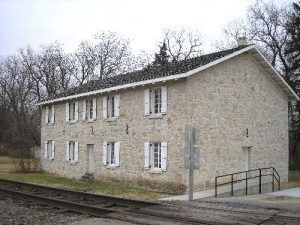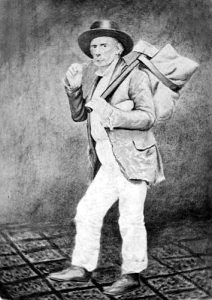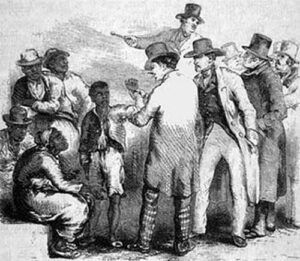The Government of a Territory. When a territory is organized, it must be provided with a government. The people in a territory may not elect their officers as in a state; they may elect a legislature and a delegate to Congress, but the President appoints the governor, secretary, judges, and certain other officers.
The First Territorial Governor. In October 1854, the first Territorial Governor, Andrew H. Reeder, arrived in Kansas; although he was known to favor slavery, he was heartily welcomed by all the people. That he might become familiar with conditions in the Territory, Governor Reeder made a tour of inspection shortly after his arrival. Although this was little more than four months after the opening of the Territory, he found several settlements scattered over eastern Kansas. Towns were springing up, and the prairies were dotted with the tents and cabins of the pioneers. Several thousand people had arrived, some Free-State and some pro-slavery. The pro-slavery settlers had brought a few slaves. There were also many Indians here, for only a part of the tribes had as yet been removed.
The First Election Called. On his return from his observation tour, which had included the most remote settlements, as far west as Council Grove and Fort Riley, Governor Reeder proclaimed the first election to be held in Kansas. The date was set for November 29, at which time a delegate to Congress was to be chosen.
Interest in the Election. The settlers were all busily engaged in building cabins and otherwise providing for the coming of winter, and since this election was not deemed of much importance, they took little interest in it. This was not the case, however, with the Missourians. At this first election, under the leadership of their Senator, David R. Atchison, they gave an exhibition of the methods they expected to control Kansas.
Election Day, November 29, 1854. On the day before the election, the Blue Lodge voters began to cross the border into Kansas. They came well-armed and organized into companies, each of which went to a polling place. They came to vote, and they voted. There were so many of them that they could outnumber the legal voters in many precincts where they took possession of the polls. Election judges who refused to accept their votes were removed, and judges of their own were installed.
The Result. Of course, the pro-slavery delegate was overwhelmingly elected. He would probably have been elected had the Missourians stayed at home, for up to this time, most of the settlers outside of Lawrence favored slavery. The result of this unfair election was to renew the excitement in the North at such a working out of the principle of “popular sovereignty.” But the Free-State pioneers were not to be discouraged. They continued, during the winter, their home building, preparations for spring cultivation, and securing titles to their land.
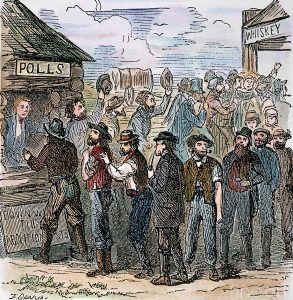
Voting in Kansas
The Second Election, March 30, 1855. The first event of importance in the new year was the taking of the census of the Territory in the spring. It showed a total population of 8,601, with about 3,000 voters. A little later, a date was set for the election of a Territorial Legislature. Since this body of men would make the laws for the Territory, there was no lack of interest among the settlers in this election. It was well understood that the Missourians were expecting to vote again. Money was being raised, and men were hired to march into Kansas on election day. They came, fully 5,000 armed with pistols, guns, and bowie knives, and marched to the different polling places. They did not pretend to be residents of Kansas but boasted that they were from Missouri.
They were disorderly and dangerous and, in many cases, drove the legal voters from the polls. Not more than half of the 3,000 rightful voters cast ballots in this election, but the count showed that more than 6000 ballots were cast. The “Bogus Legislature.” The whole thing had been so openly fraudulent that the Free-State people demanded that the Governor set aside this election and call a new one. The Missourians threatened his life if this were done.
When the day came to decide the question, the men who had been fraudulently elected gathered in the Governor’s office, armed and defiant. The Governor and several friends there to protect him were also armed. Bitter discussion ensued, but there was no fighting. Contests had not been filed against all of the men elected. Governor Reeder decided to recognize the election except where sufficient proof of fraud was shown. In these cases, he threw out the returns and ordered another election. The pro-slavery men took no part in the new election, and several Free-State men were chosen to the Legislature. When the Legislature met, the pro-slavery majority promptly unseated these Free-State members and recognized the men first elected. This gave the Territory an entirely pro-slavery legislature. It was called by the Free-State people the “Bogus Legislature.” The pro-slavery leaders were Benjamin F. Stringfellow and David R. Atchison, both of whom lived in Missouri but actively participated in Kansas affairs. Senator Atchison said, “We wish to make Kansas in all respects like Missouri.”
So they adopted the whole body of Missouri laws and added a series of slave laws that were probably the most severe ever enacted in the United States.
The First Legislature, at Pawnee, July 1855. The Governor chose Pawnee as the place where the Legislature should meet. Pawnee was a new town on the Kansas River, within the present bounds of the Fort Riley military reservation. Since it was west of nearly all the settlements, the members had to make long journeys to reach it. Both because of the inconvenience of location and because the pro-slavery members desired to be nearer the Missouri border, the Legislature remained in session at Pawnee for only five days, just long enough to unseat the Free-State members and to pass an act removing the seat of government temporarily to Shawnee Mission in Johnson County. All that remains of Pawnee today is the old stone building that was erected for a capitol.
The Removal of Governor Reeder. Governor Reeder had refused to accede to all the demands of the pro-slavery people and had fallen into disfavor with them. When he refused to sign some of their measures, they petitioned the President for his removal, which soon followed. Governor Reeder’s administration had lasted through less than a year of these troublous times. In the summer of 1855, with the Territory little more than a year old, the people were divided into two bitter factions, pro-slavery and Free-State, with the pro-slavery people congratulating themselves upon being rid of a Governor they could not control upon having the support of the President, and upon having a Legislature unanimously pro-slavery. Daniel Woodson, the Territorial Secretary, who now became Acting Governor, approved the acts of the pro-slavery Legislature.
Gloomy Outlook for the Free-State People. These were dark days for the Free-State people; they had no hand in the Government and no recognition of the laws of the Territory. They were denounced, misrepresented, and ridiculed. To add to the gloom of the situation, the new Territorial Governor, Wilson Shannon, initially ignored the existence of Free-State citizens. No community could obey the slave laws passed by the “BogusLegislature” without becoming pro-slavery. But the Free-State people had no intention of becoming pro-slavery; they had no intention of giving up the struggle. They found themselves confronted with the question of what was to be done. It was a very grave situation.
Summary. The first Territorial Governor, Andrew H. Reeder, arrived in October 1854. After a tour of inspection, he called an election to choose a Territorial delegate to Congress. Although there were probably enough pro-slavery settlers to carry the election, the Missourians, to make sure, came over in force and elected their candidate with an overwhelming majority. Another election was called in March to choose members of a Territorial Legislature. The Missourians came again, and although the census had shown 3,000 voters in Kansas, there was twice that number of ballots cast. On proof of fraud, Governor Reeder threw out the contested returns, and Free-State men were elected. However, when the Legislature met, the pro-slavery majority unseated them and recognized those first elected. The Governor chose Pawnee as the Territorial capital, but after five days, the Legislature adjourned to Shawnee Mission. The measures passed were entirely in the interest of slavery. Although Governor Reeder came to Kansas favoring slavery, he disapproved of the methods of the pro-slavery people. He was removed in July 1855. He was replaced by Wilson Shannon, who sympathized with slavery interests. Every condition was unfavorable to the Free-State people at this time.
Compiled & edited by Kathy Alexander/Legends of America, updated January 2023. Source: Arnold, Anna E.; The State of Kansas; Imri Zumwalt, state printer, Topeka, Kansas, 1919.
Also See:

